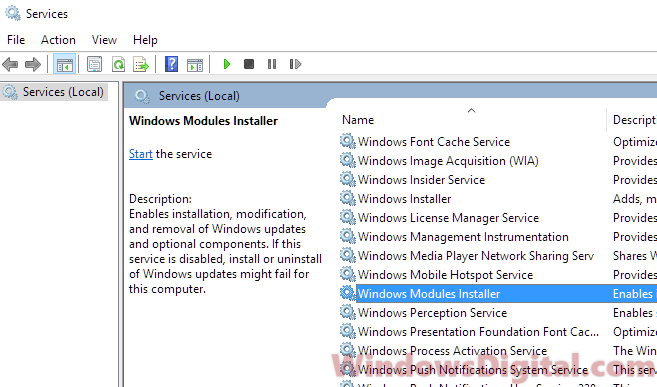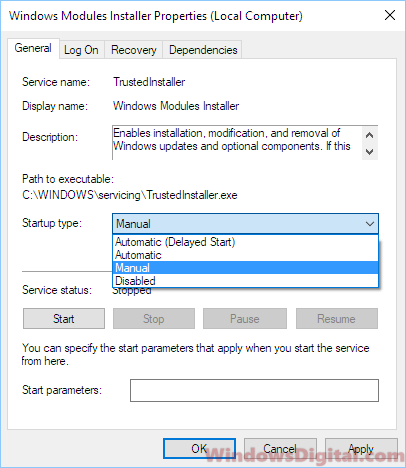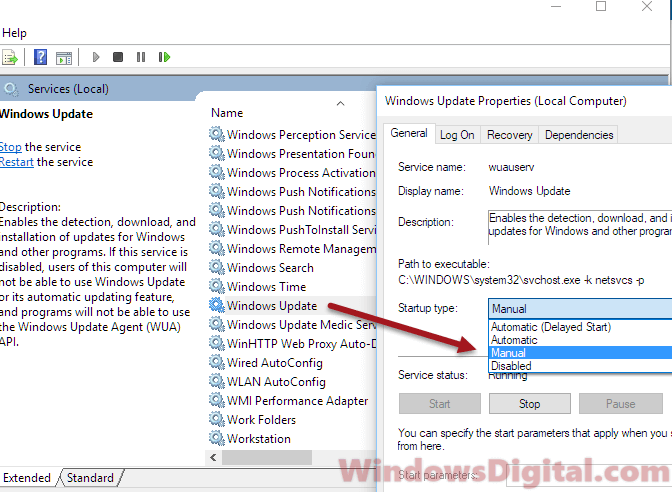While carrying out a resource-intensive task, a sudden spike in CPU or memory usage is common. This spike usually goes down after some time or when the task is finished. However, there are times when certain processes, like the Windows Modules Installer Worker, shows 100% disk usage in the task manager. This sudden issue leads to a stuttering and sluggish computer without any resources to handle additional tasks.
The Windows Modules Installer Worker’s CPU or memory usage skyrocketing to 100% leaves users wondering about its causes. Regardless of this spike affecting the performance, this issue is not worrisome and can be fixed easily using the methods explained below.
What is Windows Modules Installer Worker (WMIW)?
Windows Modules Installer Worker, WMIW, or TiWorker.exe, is a critical Windows core system process whose function is to check and install Windows updates automatically. This process has administrator-level permissions and works in the background to install all the necessary updates without needing any user interference.
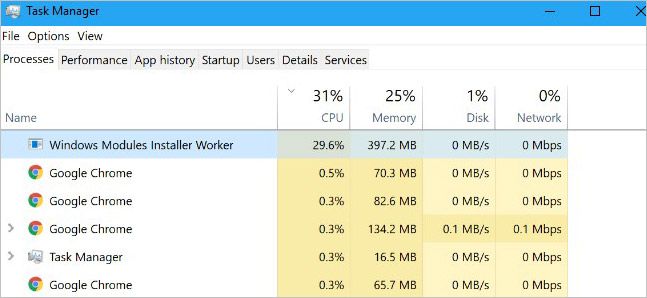
Like any other Windows process or application, the Windows Modules Installer Worker requires some power to work efficiently. Apart from installing updates, the TiWorker.exe also ties up various important system resources like .NET to keep essential processes working smoothly.
While installing updates, it can run into problems, leading to Windows Modules Installer Worker 100% disk usage issue.
Why does the Windows Modules Installer Worker reflect High CPU Usage?
Upon checking the task manager and finding the Windows Modules Installer Worker high CPU usage issue, we assume that the process, in itself, is corrupt or causing problems.
However, there are many other reasons that can cause the Windows Modules Installer Worker high CPU usage. The reasons could be – a malware infection, broken update installer, insufficient power supply, faulty memory or disk, and more.
Windows Modules Installer Worker 100% disk usage can also be due to dust build-up and improper airflow inside the CPU cabinet, resulting in computer overheating and subsequent effects like stuttering, unexpected frame drops, and system crashing.
Methods to Fix the Windows Modules Installer Worker 100% Disk Usage
There is no single cause behind the Windows Modules Installer Worker high disk usage. Nevertheless, we have explained several fixes below that might help fix potential triggers causing this issue.
Method 1: Perform a Clean Boot
A clean boot boots the computer with a minimum set of essential processes and applications. Doing this will help you figure out if the Windows Modules Installer Worker high CPU usage is due to a background program interfering with the TiWorker.exe process. The steps to do this are simple –
- Press WINDOWS + R and type msconfig. Press Enter.
- You’ll see the System Configuration screen.
- Navigate to the Services tab and check the Hide all Microsoft services option.
- Then, click on Disable all to disable all third-party services.
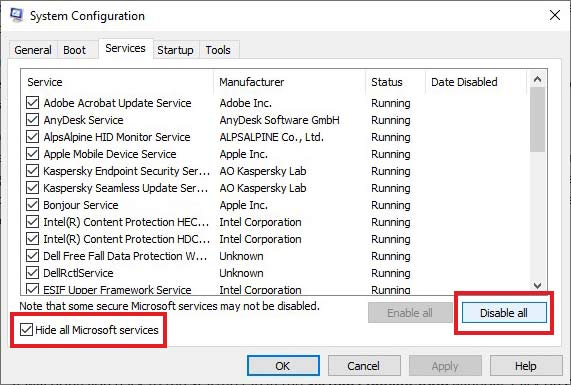
- Then, go to the Startup tab and click on Open Task Manager.
- In the startup tab, disable all the applications. Close the Task Manager.
- It will bring you back to the Startup tab in the System Configuration window. Click on OK.
- Restart your computer. Your computer will boot in a clean boot environment.
Method 2: Run Memory Diagnostics
Faulty RAM module/s might be causing the Windows Modules Installer Worker high CPU usage issue on your system. You can test the memory modules via Windows’ built-in memory diagnostics tool. Here’s what to do –
- Press WINDOWS + R and type mdsched.exe. Press Enter.
- Click on Restart now and check for the problems option.
- Wait for the tool to finish the scan and restart the computer.
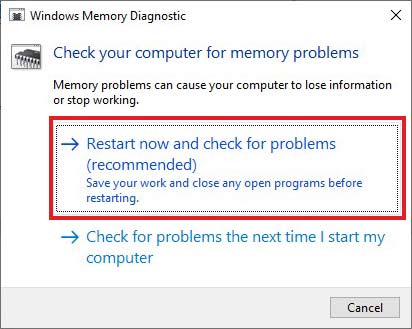
Note – Make sure to save everything and close all applications before using it.
Method 3: Do a Comprehensive Malware Check
A malware inside your system might have already replaced the real Windows Modules Installer Worker process and mimicking it for suspicious activities. If you see something suspicious or you are facing the Windows Modules Installer Worker 100% CPU usage error after visiting a random webpage or connecting an unknown device to your system, perform a virus scan on your Windows PC. Use a reliable and well-renowned antivirus for this purpose.
Method 4: Set PC performance to the Best
Unwanted features like visual effects can hog up the system resources, leading to other processes like TiWorker.exe to stall or show 100% disk usage. You can fix this by opting for the best performance. To do this –
- Open My PC.
- Right-click on the blank space and click on Properties.
- Click on Advanced system settings to open the System Properties window.
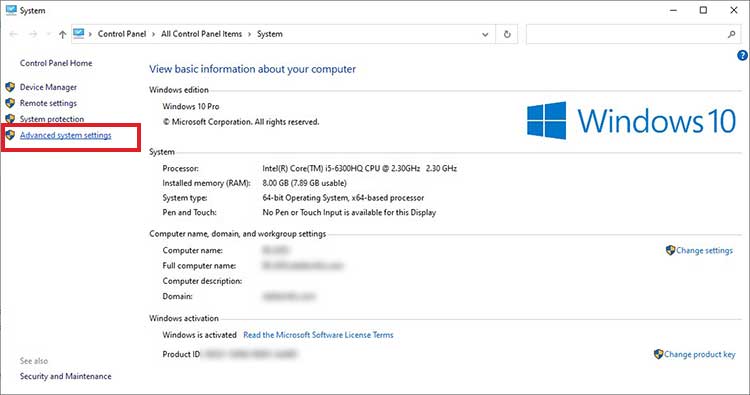
- Under the Advanced tab, go to the Performance section and click on Settings.
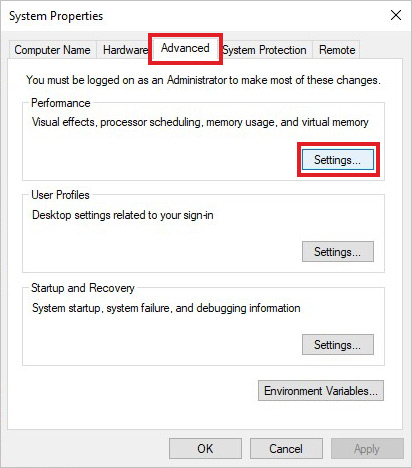
- In the Performance Options window, under the Visual Effects tab, click on Adjust for best performance.
- Click OK.
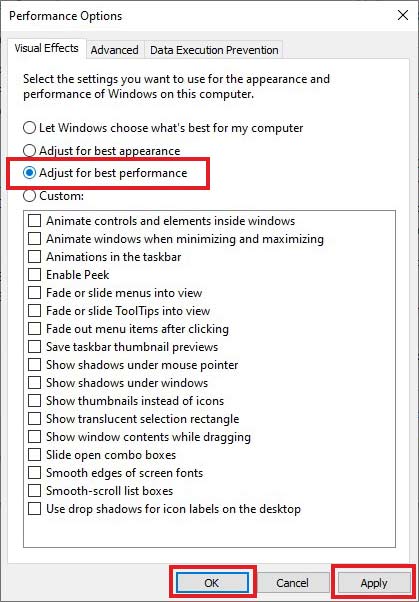
Method 5: Set Windows Modules Installer Worker to Manual
Automatic update installation in Windows is a great way to prioritize other important tasks. However, in some scenarios, it has issues that lead to Windows Modules Installer Worker 100% CPU usage. You can fix this by toggling the service to ‘manual’ mode. To do this –
- Press WINDOWS + R and type services.msc. Press Enter.
- Locate the Windows Module Installer and right-click on it. Click on properties.
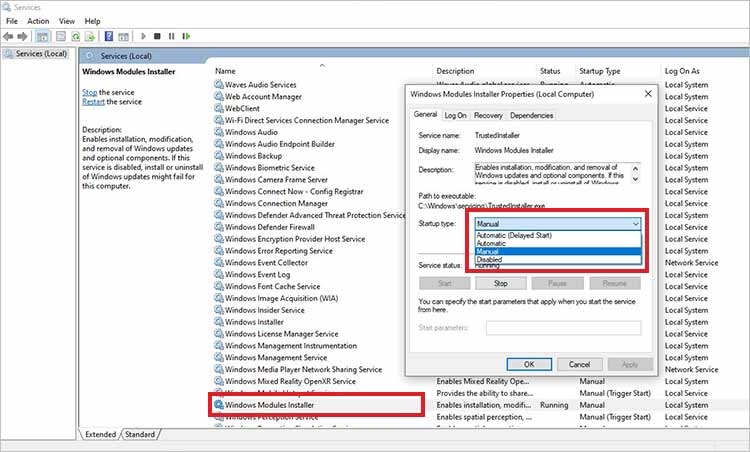
- Change the Startup type to manual.
- Click on Apply and OK.
Method 6: Delete the SoftwareDistribution Folder
SoftwareDistribution is a folder that Windows uses to temporarily store files required for installing Windows updates. These files can sometimes conflict with the Windows Modules Installer Worker process, resulting in high CPU usage errors. You can fix the TiWorker high CPU usage by deleting the SoftwareDistribution folder. Here are the steps for doing this –
- Press WINDOWS + R and type services.msc. Press Enter.
- Locate the Windows Update service and stop it.
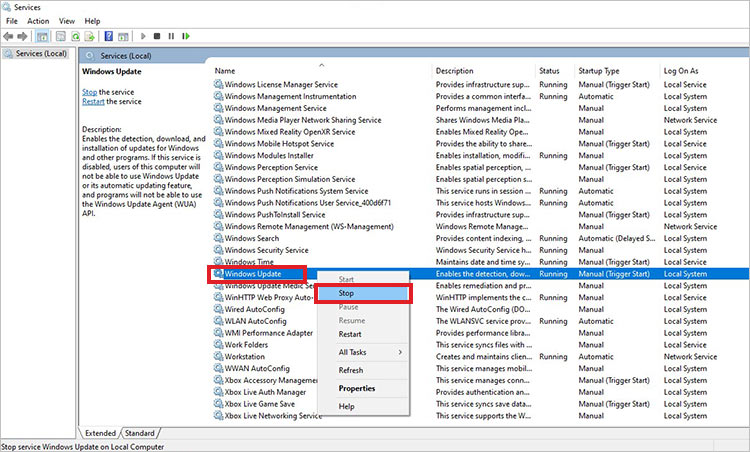
- Close the Services Window and again press WINDOWS + R.
- Type C:\Windows\ and press Enter.
- Navigate to the SoftwareDistribution folder and delete it.
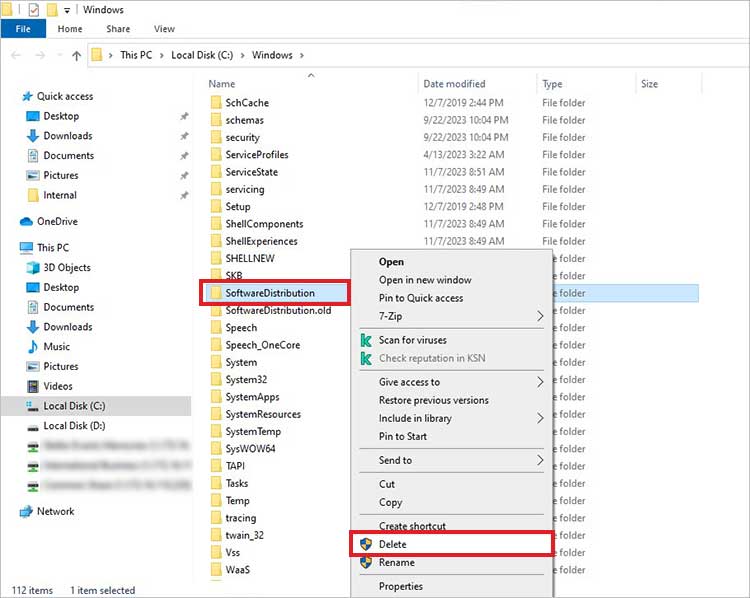
You can also clean other temporary files from your computer to clear all unwanted files on your computer.
Method 7: Run Windows Update Troubleshooter
If there is a problem with the Windows updater itself, it can cause the Windows Modules Installer Worker 100% usage on your Windows computer. You can resolve the underlying problem by running the Windows update troubleshooter. For this –
- Press WINDOWS + I to open Settings.
- Click on Update & Security.
- Click on Troubleshoot in the left pane.
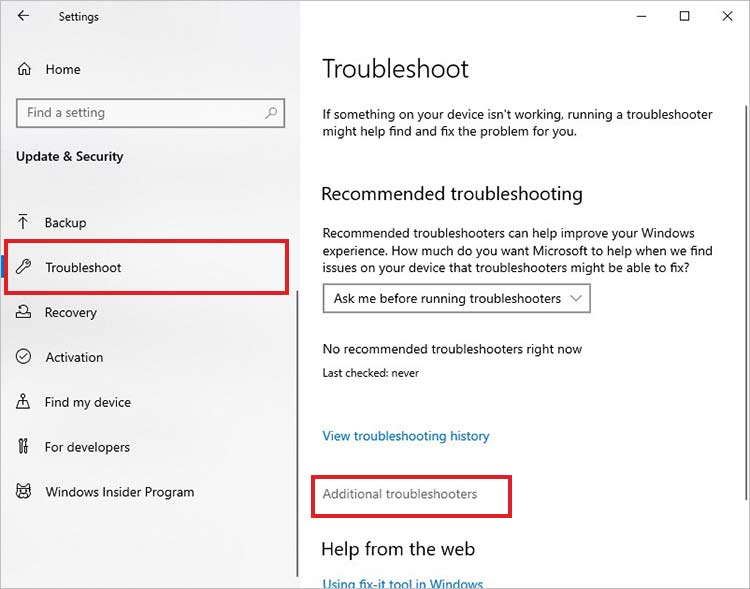
- Click on Additional troubleshooters.
- Locate the Windows Update troubleshooter and click on it.
- Click on Run the troubleshooter. Follow the on-screen instructions afterward.
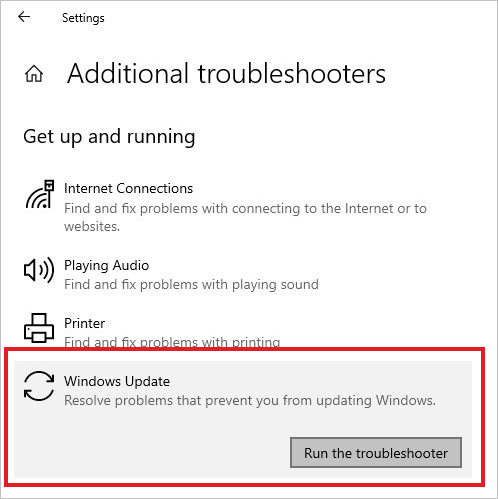
Reduce Unnecessary CPU Usage
The Windows Modules Installer Worker (WMIW) 100% disk usage is an unusual behavior indicating high CPU/disk image that can slow down the computer.
Using the methods explained above, you can fix the Windows Modules Installer Worker high disk usage issue in no time. And, if your computer is constantly stuttering and crashing due to high CPU usage, try using System Restore to restore the PC to a previous error-free state.
If you accidentally deleted some files on your sluggish computer, worry not and use a powerful Windows data recovery software to recover them.
[FIXED] — Svchost.exe High CPU usage
How to fix modern setup host high CPU usage issue?
Methods to fix WUDFHost.exe high CPU usage on Windows PCs
[FIXED] – Antimalware service executable high CPU usage issue
Is the Windows Modules Installer Worker process essential?
Yes, WMIW or Windows Modules Installer Worker is a core system process that automatically installs various OS and security updates. It also ensures that essential processes are working smoothly.
What causes 100% Disk usage?
Multiple instances of an application running simultaneously, too many applications running parallel, malware or cryptominer working in the background are some of the reasons behind high disk usage.
Will upgrading RAM or SSD solve 100% usage issue?
In some cases, if the 100% usage is due to insufficient RAM or old HDD, upgrading RAM and switching to SSD can help you resolve high CPU/memory issue.
Was this article helpful?
YES7
NO
If you’ve checked your computer’s Task Manager, you might have seen a process called “Windows Modules Installer Worker” using a lot of CPU or disk space in Windows 10 or Windows 11. Usually, this process is fine and does nothing bad unless it keeps using a lot of resources for a long time. In this guide, we’ll talk about what this process is all about and how you can reduce its workload.
Also see: High CPU Usage After Windows 11/10 Update (Fix)

What is Windows Modules Installer Worker?
Windows Modules Installer Worker, also known as TiWorker.exe, is a service that helps Windows Update find and install new updates from Microsoft. This process runs automatically in the background when you check for updates on your PC or when Windows Update schedules it.
How to fix high CPU usage caused by Windows Modules Installer Worker
If this is your first time seeing this process, it’s best to just wait it out since it might be installing important updates for your Windows 10 or 11. But if it keeps using a lot of CPU or disk space after waiting, you can switch the Windows Modules Installer Worker service to manual. This change makes sure the process only runs when you want it to.
Just be aware that if you end this process using “End Task” in Task Manager, it will restart soon after. Setting the service to manual is the only full-proof way to stop it from running without your permission. However, doing this means Windows Update won’t run on its own anymore. You’ll have to check for updates yourself through the Windows Update interface. Before you decide to stop the service completely, you might want to try the Windows Update Troubleshooter to see if the problem comes from the Windows Update service itself.
Another big reason to manage this process is its impact on battery life, especially if your laptop uses power even when it’s plugged in. Setting Windows Update to manual might help with this issue.
Pro tip: How to Limit CPU Usage of a Process in Windows 11
How to set Windows Update to manual
To set the Windows Modules Installer Worker service to manual and only run on demand, follow the steps below.
- Go to the start menu in Windows.
- Search for “services.msc” and open it.
- Find “Windows Modules Installer” in the list of services and double-click on it.
- Change the Startup type to Manual.
- Click Apply, then OK.
- If you want it to stop right now, you can click the Stop button.
- Then, look for “Windows Update” and double-click on it.
- Change the Startup type to Manual.
- Click Apply, then OK.
- Close the Services window and restart your PC.
After you restart, open Task Manager to see if Windows Modules Installer Worker is still causing high CPU, disk, or memory usage in your Windows 10 or 11.
This method will stop automatic Windows Update, so also remember to check for updates on your own regularly, as your computer won’t do it for you anymore.
Delete corrupted update files
If Windows Modules Installer Worker is still using a lot of CPU or disk space because of corrupted update files, you can delete the Software Distribution folder in Windows. This folder holds temporary files that Windows Update uses and clearing it often fixes issues with corrupted files.
- Open Command Prompt as an administrator. Right-click on the Start menu and choose “Command Prompt (Admin)”.
- Type these commands one at a time, hitting Enter after each:
net stop wuauserv net stop cryptSvc net stop bits net stop msiserver
These commands stop the services related to Windows Update.
- Rename the Software Distribution folder with this command:
ren C:\Windows\SoftwareDistribution SoftwareDistribution.old
This changes the folder’s name to SoftwareDistribution.old, which removes it so Windows can create a new one.
- Restart the services you stopped with these commands:
net start wuauserv net start cryptSvc net start bits net start msiserver
This restarts the Windows Update services.
After doing these steps, check if the issue with high CPU or disk usage by Windows Modules Installer Worker is fixed.
Consider upgrading your hardware
When you frequently run into issues with high CPU or disk usage and software solutions haven’t always fixed the problem, you might want to consider hardware upgrades. Adding more RAM or getting a solid-state drive (SSD) can really help your computer run faster. If changing the CPU is possible, it would give you an even bigger boost. This is especially the case if you have a rather old computer with more than 7-8 years old hardware parts and you have to use some of the latest and big software.
Windows Modules Installer worker (TiWorker.exe) is a crucial component on Windows PC responsible for looking for newly available Windows system updates and installing them on your computer. It’s a legitimate system process associated with the Windows Update service ensures that your system is up-to-date and secure. However, at times, Windows 11 Modules Installer Worker can lead to high disk or CPU usage causing performance issues. Several users report computer’s disk usage is unusually high and identified “Windows Modules Installer Worker” as a contributing factor. This article explores the common reason behind Windows Modules Installer Worker High Disk usage and solutions to fix it on Windows 11/10.
Contents
- 1 What is Windows Modules Installer Worker?
- 2 Windows Modules Installer Worker high Disk
- 2.1 Allow Windows updates to complete
- 2.2 Run Windows Update Troubleshooter
- 2.3 Reducing the priority of TiWorker
- 2.4 Tweak SoftwareDistribution folder
- 2.5 Check Disk Drive Errors
- 2.6 Fix Corrupted System Files and Services
- 2.7 Disable Windows Modules Installer Service
Windows Modules Installer Worker (WMIW) or TiWorker.exe is just a Windows service. That keeps running in the background and searching for new Windows updates. Also, It prepares your computer for installation and checks frequently for new updates.
Its primary objective is to ensure that the computer is equipped with the latest software enhancements, security patches, and performance improvements provided by Microsoft.
Windows Modules Installer Worker high Disk
Usually, the Windows modules installer worker (TiWorker.exe) will terminate all the resources that are necessary for an update once the update is finished. But Sometimes Due to various reasons, these resources will keep on running in the background, Or the process Stuck. This causes High System Resource usage or Windows PC became unresponsive and results from High CPU or 100 % Disk Usage Problems.
Several factors can lead to high disk usage by Windows Modules Installer Worker:
Pending Updates: When there are a large number of updates pending installation, TiWorker.exe may use a significant amount of system resources.
Corrupted Update Files: If update files are corrupted or incomplete, the process may struggle to install them, leading to high disk activity.
Conflict with Antivirus: Certain antivirus programs may conflict with the update process, causing it to consume excessive disk resources.
Insufficient System Resources: If your system has limited RAM or processing power, TiWorker.exe may appear to be using a disproportionate amount of resources.
Stuck Update Process: Occasionally, an update may get stuck or encounter an error, causing the installer worker to continuously attempt installation.
Allow Windows updates to complete
Windows 11 Modules Installer Worker handles the Windows updates process and makes changes to the system’s files and configuration. This involves replacing or adding new files, modifying settings, and sometimes even removing obsolete components. If for some reason this process is interrupted, can lead to conflicts and high disk usage by the Windows Modules Installer Worker.
Let’s first check and make sure there are no more pending updates stuck for downloading or installing which may cause the problem.
- Press Windows key + I to open the settings app
- Go to Windows Update then hit the check for Updates button,
- If new updates are available, allow them to download and install
- This might take some time depending on the number of pending updates.
Once done, restart your computer to apply the changes and check if the disk usage is normal.
Also if you get any Update installation errors or stuck downloading then check this guide to fix Windows update problems.
Run Windows Update Troubleshooter
When there are issues with Windows Updates, the Windows Modules Installer Worker may struggle to complete its tasks. This can lead to it using a significant amount of CPU resources or Disk usage as it attempts to install, modify, or remove updates.
In such situations, running the Windows update Troubleshooter helps address the underlying problems with updates, which in turn can reduce the strain on the CPU caused by the Installer Worker’s attempts to manage those updates.
- Press the Windows key + X and select Settings,
- Go to system then Troubleshoot and click on Other troubleshooters
- Click Run next to Windows Update and follow the on-screen instructions.
- This will help identify and fix common problems with Windows Updates.
Reducing the priority of TiWorker
Reducing the priority of the Windows Modules Installer Worker (TiWorker) process can be a potential solution to mitigate its impact on system resources. Lowering its priority means that it will use fewer CPU resources, which can reduce the strain on your computer.
- Navigate to the Start Menu & search for Task Manager.
- In Task Manager, go to the “Processes” tab.
- Look for TiWorker.exe and right-click on it. Set priority to low. (temporarily you can select the End process tree to stop the TiWorker process)
A warning message will appear informing you that changing process priorities can affect system stability. Click “Change priority” to confirm. Check if it reduces Tiworker.exe high CPU usage.
Tweak SoftwareDistribution folder
Resetting Windows update components clear any underlying issues that may be causing the Modules Installer Worker to consume excessive disk resources. This process essentially provides a clean slate for the update process to function properly, which can help alleviate the high disk usage issue.
This process essentially clears out the old update cache and resets the components responsible for managing updates.
- Press the Windows key + R, type services.msc and click ok
- Locate Windows Update service, right-click on it select stop
- Now press Windows key + E to open File Explorer and navigate C:\Windows\SoftwareDistribution\Download.
- Delete all files and folders inside the Download folder, press Ctrl + A to select all, and hit the Del key.
Now restart the Windows update service, next time you check for Windows updates, your system will recreate the necessary folders and files, hopefully resolving any issues that were causing high disk or CPU usage.
Check Disk Drive Errors
Sometimes disk Drive Errors or bad sectors on hard drive is the reason for High Disk usage on Windows 11. Running a disk check can identify physical problems with the hard drive, such as bad sectors or other hardware-related issues. These can cause high disk usage and other performance problems.
- Simply open the command prompt as administrator then type command chkdsk c: /f /r and hit the enter key.
- When asking for a scheduled disk check on the next restart press Y key and restart Windows.
CHKDSK checks the integrity of the file system on a disk. It looks for structural inconsistencies, cross-linked files, and other issues that can occur over time. It ensures data integrity, recovers data from damaged areas, and can improve overall disk performance.
Regularly checking for disk errors is considered a standard maintenance practice to ensure the health and longevity of your storage device.
Fix Corrupted System Files and Services
Again corrupted system files can indeed cause the Windows Modules Installer Worker to exhibit high CPU or disk usage. When system files are damaged or incomplete, it can impede the update process managed by the Windows module installer. This leads to increased processing demands as the system attempts to rectify or work around these file issues.
You can run System File Checker (SFC) and Deployment Image Service and Management Tool (DISM) to scan and repair issues with the system files and the Windows image.
Press Windows key + S, type cmd and select run as administrator to open Command Prompt with administrative privileges.
Type the command sfc /scannow and press Enter. The SFC will begin scanning for and repairing corrupted files. This process may take some time.
Next, run the DISM command, DISM /Online /Cleanup-Image /RestoreHealth to check for and attempt to repair the Windows image.
SFC scans and repairs corrupted or missing system files in Windows, DISM repairs the Windows image, which includes the operating system files and components.
Once the scanning completes 100%, restart your PC and check if this helps fix the Windows 11 modules installer worker High CPU or Disk usage problem.
Disable Windows Modules Installer Service
Windows 11 Modules Installer Worker high CPU or Disk usage persists after trying the above solutions? You should set Windows Update Service and Windows Modules Installer Worker to manual.
- Press the Windows key + R, type services.msc and hit the enter key.
- Then scroll down and look for Windows Modules installer worker, right-click it, and select Properties
- Change the Startup type To Manual / Disable and Stop the Service next to service status.
Again Repeat this step for the Windows Update service.
Then restart Windows And check There is no more high Disk usage 100 % CPU usage.
Also, Read
- Fix a Boot Configuration Data File is Missing Error 0xc0000034
- Fix This device can’t use a Trusted Platform Module Turn on Bitlocker
- 5 Tips to Fix 100% Disk Usage Problem in Windows 10, 8.1 and 7
- Solved: 100% Disk usage in a new laptop running Windows 10
- Solved: Windows 10 High CPU usage after update!
Windows Module Installer (also known as TrustedInstaller.exe) is a Windows service that is responsible for installing, modifying, and removing system components, updates, and optional Windows features. It is an integral part of the Windows operating system, starting from Windows Vista and onwards.

The main purpose of the Windows Module Installer is to ensure the integrity and security of the Windows operating system by managing the installation and servicing of Windows updates, service packs, and other system components. It is designed to protect critical system files and prevent unauthorized modifications, thereby maintaining system stability and reliability.
The Windows Module Installer runs with elevated privileges and has the ability to access and modify system files and registry settings. It is usually active in the background, working silently to manage the installation and maintenance of system components. However, it may become more noticeable during specific system updates or when installing optional Windows features.
Why is Windows Module Installer Utilizing 100% of My Disk?
It makes sense that the Windows Module Installer would be responsible for excessive disk or CPU usage in Windows, given how time-consuming updates to Windows and its related programs can be. You will often observe increases in CPU and disk usage during updates in Task Manager.
However, if you continue to experience 100% disk utilization and high CPU usage for an hour or more after the updates have been completed, you might have a problem. When stress testing your CPU, sustained high CPU usage is normal; however, it is not normal after an update, as it can result in high CPU temperatures. Increased CPU temperatures can lead to slowdowns, freezes, and even shutdowns.

If you are noticing continuous high disk and CPU usage from Windows Modules Installer, it is time to examine it more closely. Here is how to prevent Windows Modules Installer updates from consuming your CPU and disk resources:
1. Running Windows Memory Diagnostic Tool
You can use this tool to ensure that the issue is not hardware-related. Your computer’s RAM module may have problems, causing instability which this tool allows you to identify.
- Click on the Start button located at the bottom left corner of your screen.
- Type “Windows Memory Diagnostic” in the search bar. You should see the tool appear in the search results.
- Click on the “Windows Memory Diagnostic” tool from the search results to launch it.
Open Windows Memory Diagnostic. - The tool will present you with two options:
1. Restart now and check for problems (recommended): This option will immediately restart your computer and initiate the memory diagnostic test during the startup process.
2. Check for problems the next time I start my computer: This option allows you to schedule the memory diagnostic test for the next time you restart your computer.Choose between “Restart now and check for problems” or “Check for problems the next time I start my computer”. - Choose the option that suits your preference. Keep in mind that if you choose the first option, any unsaved work will be lost when your computer restarts.
- Once the memory diagnostic test starts, it will run a series of tests to check for memory errors. The process may take several minutes to complete.
- After the memory diagnostic test finishes, your computer will restart. Upon startup, you’ll be able to view the test results, which will indicate if any memory issues were detected.
2. Running Windows Update Troubleshooter
The Windows Update Troubleshooter is a built in tool in Windows that helps diagnose and resolve issues related to Windows updates. While it mainly focuses on resolving problems with the Windows Update service, it can also be helpful in identifying issues with the Windows Module Installer (TrustedInstaller.exe) if it is causing high CPU and disk usage.
- Click on the Start button and then the gear icon for the Windows Settings app and Navigate to “Update & Security” > “Troubleshoot” > “Additional Troubleshooters”.
- In the “Additional Troubleshooters” section, select “Windows Update” and click on “Run the troubleshooter”.
In the “Additional Troubleshooters” section, select “Windows Update” and click on “Run the troubleshooter”. - The Windows Update Troubleshooter will run a series of automated checks and diagnostics to identify and resolve common Windows Update issues. It may take some time to complete.
- Once the troubleshooter has finished, it will provide a summary of the issues it found and any problems it was able to fix. Pay attention to any specific mention of problems with the Windows Module Installer.
Results of the Windows Troubleshooter scan. - If the Windows Update Troubleshooter identifies issues with the Windows Module Installer, it will attempt to apply appropriate fixes. Follow the troubleshooter’s instructions to implement these fixes.
- After applying the recommended fixes, monitor the CPU and disk usage to see if the problem with high usage by the Windows Module Installer is resolved.
While the Windows Update Troubleshooter can be helpful in resolving issues related to the Windows Module Installer, it is important to note that it might not address all possible causes. If the problem persists, refer to the fixes below.
3. Running the “CHKDSK” command
Running the CHKDSK (Check Disk) command can help you find and fix issues with the file system and disk errors on your PC. While it may not directly address problems specifically related to the Windows Module Installer, it can indirectly assist in resolving high CPU and disk usage caused by disk related issues.
- Press the Windows key, search for “Command Prompt,” right-click on it, and select “Run as administrator.” This will run Command Prompt will administrator privileges.
- In the Command Prompt window, type “chkdsk C: /f /r” and press Enter. Replace “C:” with the appropriate drive letter if your Windows installation is on a different drive.
chkdsk C: /f /r
In the Command Prompt window, type “chkdsk C: /f /r” and press Enter. - CHKDSK will begin scanning the selected drive for errors and attempt to fix any it finds. The process may take a while, depending on the size and health of your disk.
- If prompted to schedule a disk check on the next system restart, type “Y” and press Enter. Restart your computer to initiate the CHKDSK scan before the operating system loads.
If prompted to schedule a disk check on the next system restart, type “Y” and press Enter. - Once the CHKDSK scan completes and your system restarts, monitor the CPU and disk usage to determine if the high usage issue persists. If the problem was caused by disk errors or file system corruption, CHKDSK will have resolved it.
4. Running the “SFC” and “DISM” scans
Running the SFC (System File Checker) and DISM (Deployment Image Servicing and Management) scans will find and repair the existing Windows system files and other similar files on your PC.
- Press the Windows key, search for “Command Prompt,” right-click on it, and select “Run as administrator.” This will run Command Prompt will administrator privileges.
- In the Command Prompt window, type “sfc /scannow” and press Enter. The System File Checker will start scanning your system files for any errors or corruptions.
sfc /scannow
In the Command Prompt window, type “sfc /scannow” and press Enter. - The SFC scan will automatically detect and attempt to repair any corrupted system files it finds. The process may take some time to complete depending on the speed of your drive.
The SFC scan will automatically detect and attempt to repair any corrupted system files it finds. - In the same Command Prompt window, type “DISM /Online /Cleanup-Image /RestoreHealth” and press Enter. The DISM scan will check the Windows image for any issues and attempt to repair them using Windows Update.
DISM /Online /Cleanup-Image /RestoreHealth
In the same Command Prompt window, type “DISM /Online /Cleanup-Image /RestoreHealth” and press Enter. - The DISM scan will connect to Windows Update to download any necessary files and fix problems with the Windows image. This process may also take some time to finish.
- After the scans are complete, restart your computer to apply any repairs made by SFC and DISM.
- Once your system restarts, monitor the CPU and disk usage to determine if the high usage issue persists.
If corrupted system files or issues with the Windows image were the underlying cause, the scans will solve the problem.
5. Killing the “TiWorker.exe” process
TiWorker.exe is the executable file for the Windows Module Installer Worker service, which is responsible for installing updates and system components. Killing this would kill the Windows Module installer, resulting in the termination of Windows Update processes.
- Press “Ctrl + Shift + Esc” on your keyboard to open the Task Manager. Alternatively, you can right-click on the taskbar and select “Task Manager” from the context menu.
- Depending on your version of Windows, either switch to the “Processes” or “Details” tab in Task Manager. Look for the “TiWorker.exe” process in the list of running processes.
Depending on your version of Windows, either switch to the “Processes” or “Details” tab in Task Manager. - Locate the “TiWorker.exe” process in the list and click on it to select it.
- Once the “TiWorker.exe” process is selected, click on the “End Task” button at the bottom-right corner of the Task Manager window. Confirm any prompts that appear.
Alternatively, you can right-click on the “TiWorker.exe” and select End Task. - After terminating the TiWorker.exe process, monitor the CPU and disk usage to see if the high usage issue disappears. If TiWorker.exe was the cause of the problem, the CPU and disk usage should decrease.
6. Deleting the “SoftwareDistribution” Folder
Windows usually downloads and saves updates to the “SoftwareDistribution” Folder. Since the downloaded updates files are unable to install correctly, those corrupted Windows Update files result in high DIsk usage. Deleting the folder folder allows you to get rid of the corrupted files.
- Press the Windows key, search for “Command Prompt,” right-click on it, and select “Run as administrator.” This will ensure you have the necessary permissions to delete the folder.
- In the Command Prompt window, type the following commands one by one and press Enter after each:
net stop wuauserv
net stop bits
In the Command Prompt window, type the following commands one by one and press Enter after each: “net stop wuauserv” and “net stop bits”. These commands will stop the Windows Update services temporarily.
- In the Command Prompt window, type the following command and press Enter:
explorer %windir%\SoftwareDistribution
n the Command Prompt window, type the following command and press Enter: “explorer %windir%\SoftwareDistribution”. This command will open the “SoftwareDistribution” folder in File Explorer.
- In the “SoftwareDistribution” folder, select all the files and folders inside, and press the Delete key on your keyboard. Alternatively, you can right-click and select “Delete” from the context menu.
In the “SoftwareDistribution” folder, select all the files and folders inside it, right-click and select “Delete” from the context menu. - Note: If you receive a prompt stating that some files are in use and cannot be deleted, it means the Windows Update services are still running. In that case, repeat step 2 to stop the services again and then try deleting the files.
- Go back to the Command Prompt window and type the following commands one by one, pressing Enter after each:
net start wuauserv
net start bits
Go back to the Command Prompt window and type the following commands one by one, pressing Enter after each: “net start wuauserv” and “net start bits”. These commands will start the Windows Update services again.
- Once the services are started, you can close the Command Prompt window.
Deleting the SoftwareDistribution folder helps reset the Windows Update components, and Windows will recreate the necessary files and folders as needed.
7. Turning off Automatic Window Updates
Disabling Automatic Updates will stop this problem from returning in the future as you will only be able to update Windows manually when your device is not in use, allowing optimal resources to carry out the update with no errors.
- Press the Windows key on your keyboard or click on the Start button, and then click on the gear icon to open the Windows Settings.
- In the Windows Settings window, click on “Update & Security”.
In the Windows Settings window, click on “Update & Security”. - In the left-hand sidebar of the “Update & Security” section, click on “Windows Update”.
- Under the “Windows Update” section, click on the “Advanced options” link.
Under the “Windows Update” section, click on the “Advanced options” link. - In the “Advanced options” window, toggle off all the options related to Automatic Windows Updates to disable automatic updates.
In the “Advanced options” window, toggle off all the options related to Automatic Windows Updates to disable automatic updates. - Close the “Advanced options” and “Windows Update” windows to save the changes. Your system will no longer automatically download and install Windows updates.
By turning off automatic Windows updates, you can have more control over when and how updates are installed on your system.
However, it’s important that you regularly update your operating system as it is crucial for security and stability. When you disable automatic updates, it becomes your responsibility to manually check for and install important updates to ensure your system remains protected.
Muhammad Zubyan
Muhammad Zubyan is a certified Google IT Support Professional with over 7 years of extensive experience. He has worked on more than 1500 computers, gaining valuable insights that enable him to detect and troubleshoot any complicated root cause of Windows-related issues and errors. In addition to managing Appuals as a Senior Editor, he is currently developing his own Game Optimization program that caters to both gamers and casual users alike.
How to Fix Windows Modules Installer Worker (TiWorker.exe) High CPU/Disk Usage on Windows 10
The Windows Modules Installer Worker (TiWorker.exe) service can cause high CPU usage on your computer. This article will show you how to fix that.
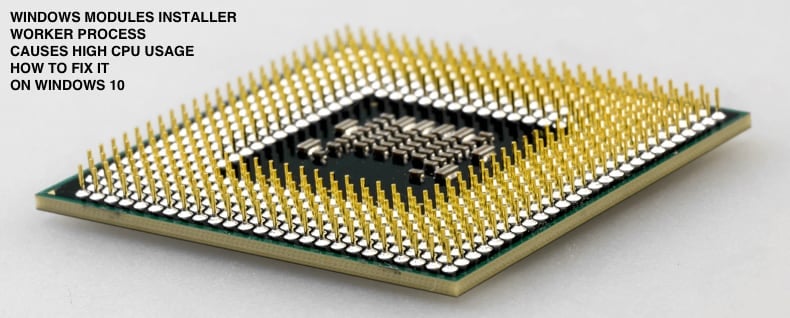
The Windows Modules Installer Worker can be recognized as TiWorker.exe in Task Manager’s Details tab list. This process is part of Windows and enables installation, modification, and removal of Windows updates and optional components. If this service is disabled, installation (or removal) of Windows updates might fail.
There are ways to decrease CPU usage caused by TiWorker.exe. However, high CPU or Disk usage by this process is normal. If you allow this process to run for some time, it will eventually stop using CPU and Disk resources.
The time taken depends on your computer’s CPU speed and storage capacity. It also depends on how many updates there are to install.
However, if you’ve waited for a long time and Windows Modules Installer Worker CPU usage remains high, try the methods below to address the issue.
Video Showing How to Fix TiWorker.exe High CPU Usage
Table of Contents:
- Introduction
- Set Windows Modules Installer’s Startup Type to Manual
- Run Full System Scan
- Run Windows Update Troubleshooter
- End the TiWorker.exe Process Using Task Manager
- Run SFC and DISM Scans
- Video Showing How to Fix TiWorker.exe High CPU Usage
Download Computer Malware Repair Tool
It is recommended to run a free scan with Combo Cleaner — a tool to detect viruses and malware on your device. You will need to purchase the full version to remove infections. Free trial available. Combo Cleaner is owned and operated by Rcs Lt, the parent company of PCRisk.com read more.
Set Windows Modules Installer’s Startup Type to Manual
Windows Services (also known as services.msc) can modify how Windows services run on your system. You can change a service’s settings for security, troubleshooting, and performance-related reasons.
You will need to access the Windows Installer service, which enables installation, modification, and removal of Windows updates and optional components. If this service is disabled, installation (or uninstallation) of Windows updates might fail.
To access Windows Modules Installer, type «run» in Search and click the «Run» result.

In the Run dialog box, type «services.msc» and click «OK» to open Windows Services.

Now, scroll down through the services list to find the «Windows Modules Installer» service. Right-click it and select «Properties» from the drop-down menu or simply double-click the Windows Modules Installer service.

Ensure that «Startup type» is set to «Manual» and click «Apply» to save any changes made.

You may also wish to apply the same settings to the Windows Update service. Find the «Windows Update» service in the list, right-click it and select «Properties» from the drop-down menu.

Ensure that «Startup type» is set to «Manual» and click «Apply» to save any changes made. Restart your computer.
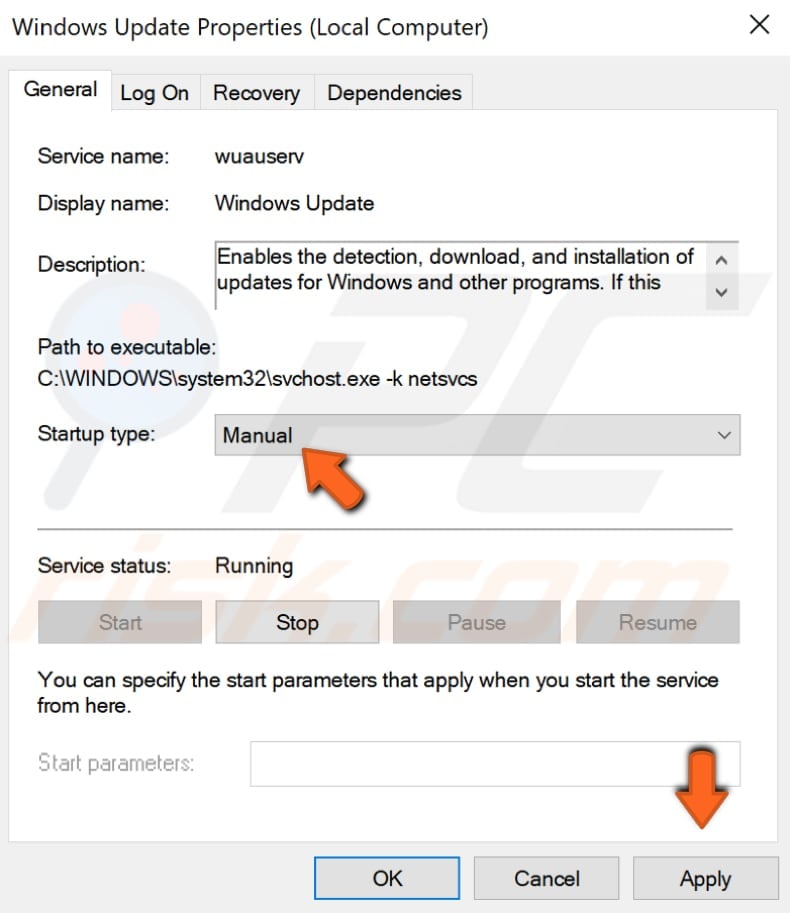
These changes to your system should stop Windows Module Installer Worker service issues. However, once the Windows Update service is configured in this way, you will have to check for updates manually.
[Back to Table of Contents]
Run Full System Scan
Malware can cause various issues on a computer, including problems with high CPU usage. Perform a full system scan and see if it detects any malware on the system. You can use Windows Defender (built-in antivirus program), which protects computers against viruses, spyware, and other malicious software. Alternatively, you can use other third-party antivirus software.
To run a full system scan using Windows Defender, type «defender» in Search and click the «Windows Defender settings» result.

Click «Open Windows Defender Security Center» on the right pane.

In the Virus & threat protection window, click «Advanced scan».

Select «Full scan» and click «Scan now». This will start scanning the system for malware. When the scan has finished, launch the program again and check if CPU usage is still high.

[Back to Table of Contents]
Run Windows Update Troubleshooter
Windows includes several troubleshooters designed to quickly diagnose and automatically resolve various computer problems. Troubleshooters cannot fix all issues but are an excellent place to start if you encounter a problem with your computer or operating system.
To start troubleshooting, go to Settings and type «troubleshoot», select «Troubleshoot» from the list.

Find «Windows Update» under «Get up and running» and select it, click «Run the troubleshooter», and follow the instructions. See if the Windows Update Troubleshooter solves the issue related to high CPU usage from the Windows Modules Installer Worker process.

[Back to Table of Contents]
End the TiWorker.exe Process Using Task Manager
Task Manager is a system monitor program used to provide information about the processes and programs running on a computer and the general status of the computer. Some implementations can also be used to terminate processes and programs and change processes’ priorities.
To open Task Manager, press Ctrl + Shift +Esc on your keyboard or right-click on the Start menu and select «Task Manager» from the contextual menu.

You will be automatically directed to the first Task Manager tab called «Processes». Here you will see a list of processes running on your system.
Select the «Details» tab and find the «TiWorker.exe» process — right-click it and select «End task» from the drop-down menu. Or, set its priority to low by selecting «Set priority» and then clicking «Low».
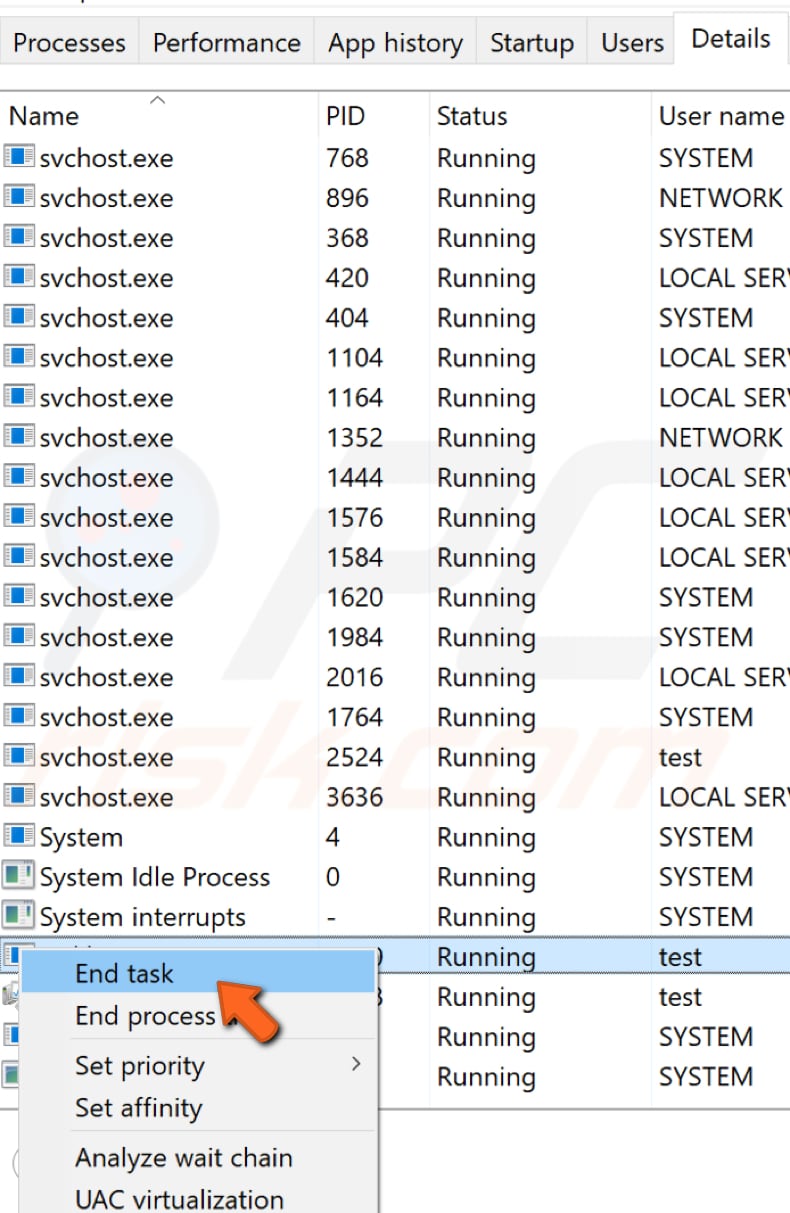
This might be only a temporary solution to the problem. The «TiWorker.exe» process might re-occur at some point.
[Back to Table of Contents]
Run SFC and DISM Scans
System File Checker (SFC) is a utility in Windows that allows users to scan for corrupted Windows system files and restore them.
To run it, first open Command Prompt first by typing «command prompt» in Search, right-click on «Command Prompt«, and then select «Run as administrator» from the drop-down menu to run Command Prompt with administrator privileges.
You must run an elevated Command Prompt to be able to perform an SFC scan.

In the opened Command Prompt window, type «sfc /scannow» and press Enter on your keyboard to execute this command. System File Checker will start and take some time to complete (approximately 15 minutes).
Wait for the scanning process to complete and restart the computer to see if you still have high CPU usage caused by the Windows Modules Installer Worker process.

Now, try running the DISM scan. DISM stands for Deployment Image Servicing and Management and can repair and prepare Windows images, including the Windows Recovery Environment, Windows Setup, and Windows PE.
To run a DISM scan, open Command Prompt as administrator and type the command: «DISM /Online /Cleanup-Image /RestoreHealth». Press Enter on your keyboard to execute it. See if this solves the issue with high CPU usage caused by the Windows Modules Installer Worker process.

We hope that this article helps solve the high CPU usage problem caused by the Windows Modules Installer Worker process. Do not hesitate to comment in the section below if you have found another workaround to this problem!
[Back to Top]

